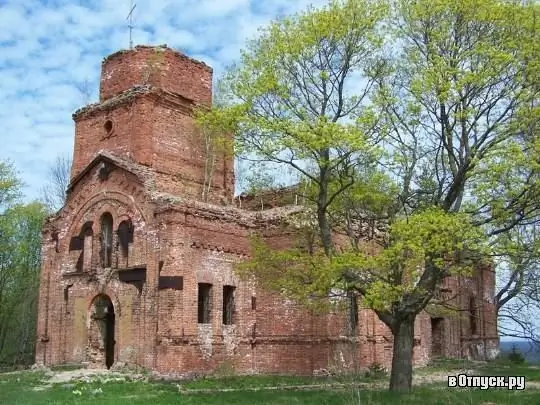
Description of the attraction
The Church of Nicholas the Wonderworker at the Soikinsky churchyard is located on the site of the now defunct village of Soikino on the Soikinsky peninsula. The peninsula is administratively part of the Vistinsky rural settlement of the Kingisepp region and is located on the southern coast of the Gulf of Finland. The temple is located in the center of the peninsula.
The name "Soikino" comes from the Izhora word for "peninsula" or "cape", and "inhabitants of this cape". The ancient inhabitants of the Soikinsky Peninsula are the Izhora people. Even more ancient inhabitants of this region are the Vod people. Vod and Izhora are the Baltic-Finnish peoples, which have been mentioned in Russian chronicles since the 9th century under the general name "Chud".
Izhora is mentioned in Russian chronicles for the first time in 1228. Izhora took part in the famous battle of the Neva with the Swedes in 1240 on the side of Alexander Yaroslavich. In 1256, according to the Orthodox rite, he baptized part of the Izhorians. But the process of establishing Orthodoxy here stretched for several centuries. Even as part of the Muscovite state, the Izhora preserved the institution of arbuyi, pagan priests. For the final approval of Orthodoxy in these places, 2 punitive expeditions were sent here in 1534 and 1548. Only after radical measures on the Soykin Peninsula did Orthodoxy become more widespread. Obviously, the construction of a church on the Soikinsky peninsula was supposed to consolidate the Orthodox faith among the Izhorians. According to reports, the temple was built before 1576.
But the final establishment of Orthodoxy here was prevented by important political and military events. The first is the defeat of Russia in the Livonian War and the capture of Russian cities by the Swedes: Ivangorod, Yam and Koporye, located near Soikino. According to the Stolbovsky Peace Treaty of 1617, the southern coast of the Gulf of Finland became part of Sweden. The Izhora land with the Soikinsky peninsula became Ingermanland, and all kinds of obstacles began to be posed to Orthodoxy. The territory of the Soikinsky Peninsula and Izhora lands were returned to Russia after the Northern War.
In 1726, instead of the old dilapidated church, a wooden church with an iron roof was built on a stone foundation in Soikino. In 1770, the temple was the center of the Nikolsky churchyard of the Koporsky district. In 1849 the church was rebuilt. The rebuilt church was cold. Therefore, thanks to the efforts of the merchant I. Adrianov, the peasant Alekseev and the honorary citizen Ivanov, as well as the funds of the Peterhof merchant I. A. Petrov and the parishioners, instead of a wooden church, they built a warm, stone church. The building was heated. Its main altar was dedicated to Nicholas the Wonderworker, and the side-altars to the prophet Elijah and Peter and Paul. The church clergy consisted of two priests, a sexton, a deacon, two clerks, and a broth.
The first abbot of the stone St. Nicholas Church was Vasily Voznesensky. Timofey Skorodumov helped him.
Nikolsky Church was closed in 1938. At that time, the main base of the Baltic Fleet, Ruchyi, was under construction on the shore of the Soykinsky Peninsula. To protect her, an anti-aircraft battery with powerful searchlights, a radio station and a military commandant's office were installed in Soikino. During the retreat in 1941, the objects were blown up. During the occupation (1942), services were resumed in St. Nicholas Church. The clergy came from Narva to serve in the church. In 1944, the services were terminated. Soikino ceased to exist after the Great Patriotic War. And the church of St. Nicholas was again abandoned.
In 1995, the Soykinsky temple was returned to the Orthodox Church and transferred to the community of the village of Vistino. The building was consecrated on May 22, 2006. Today the temple is in a dilapidated state. The interior decoration has hardly survived. The old cemetery has been dug up and is in disrepair. But the church and the surrounding area are looked after by residents of Vistino and other villages. Order is maintained in the temple and icons are re-installed so that local residents can come to pray.
Since 2010, the question of restoring the church in Soikino has been discussed. On May 31, 2011, Bishop Nazariy visited the Soykin Church and talked with the people caring for him. The main argument in support of the idea of restoring the temple is that, despite the dilapidated church, local residents maintain order in it and use it for prayers. A striking characteristic of the attitude of believers to this church is the name of this church, which is common in their midst today - "Soykinskaya shrine".






